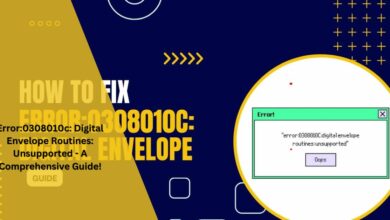0.01234567901 As A Fraction – Discover In 2024!

In the realm of mathematics, the concept of decimal numbers holds a significant place due to its practicality and versatility in calculations. One intriguing decimal, 0.01234567901, with its unique pattern of digits, presents an opportunity for exploration and analysis.
0.01234567901 as a fraction is fairly easy if the decimal is not a repeating decimal. This is because the numerator of the fraction is just all of the digits in the decimal.
The fraction’s denominator is a 1 followed by some zeros equal to the number of digits in the decimal.
This article delves into the fascinating world of decimal numbers and fractions, specifically focusing on the conversion of 0.01234567901 into a simple fraction.
Significance of the Number 0.01234567901 – The Well-Behaved Ones!
In the enchanting realm of mathematics, we find ourselves 0.01234567901 As A Fraction captivated by the unique allure of the number 0.01234567901. At first glance, it might seem like just another decimal, but this numerical gem unveils a myriad of intricacies and surprises upon closer inspection.

The fascination lies in the mesmerizing sequence of its digits, each contributing to a distinctive pattern that beckons exploration. 0.01234567901 is a mathematical puzzle that unfolds, offering a delightful challenge to those eager to decipher its secrets.
As we navigate through the labyrinth of its numerical landscape, we realize that 0.01234567901 is more than a mere collection of numbers—it is a canvas upon which the beauty of mathematical intricacies is painted.
The journey to understand the significance of this decimal becomes a thrilling adventure, inviting mathematicians and enthusiasts alike to unravel its mysteries.
With each step, the exploration becomes not just a mathematical endeavour but a discovery of the elegance and precision woven into the fabric of 0.01234567901.
Relationship Between Decimals And Fractions – One Must Know!
| Aspect | Decimals | Fractions |
| Representation of Parts of a Whole | Decimals represent parts of a whole in a numeric format. | Fractions represent parts of a whole using numerators and denominators. |
| Level of Detail | Decimals break down parts into decimal points for a detailed representation. | Fractions provide a detailed look at parts through the numerator and denominator relationship. |
| Conversion Process | Converting decimals to fractions involves recognizing the decimal’s numerical value and expressing it as a fraction. | Converting fractions to decimals involves dividing the numerator by the denominator to obtain a decimal representation. |
| Analogy | Described as being like peanut butter and jelly – inherently connected. | Analogized to a math magic trick, suggesting ease and mastery with practice. |
Step-By-Step Conversion Process – You Should Know!
Initiate the Adventure:
In a thrilling mathematical expedition as we know into the enchanting process of converting the decimal 0.01234567901 into a simple fraction.
Just like setting off on a captivating journey, initiating this adventure involves gearing up for an exploration that promises to demystify the intricacies of decimals and fractions.
Decode the Decimal:
In the second phase of our mathematical journey, we know on the critical step of decoding the decimal 0.01234567901. This process resembles a captivating mystery, where each digit carries its significance within the numerical narrative.
As we decode the decimal, the goal is to discern the role played by every digit in crafting the fractional expression.
Numerator and Denominator Revelation:
Having successfully decoded the decimal 0.01234567901, our mathematical journey progresses to the crucial stage of unveiling the numerator and denominator components.
This phase resembles a revealing exploration, akin to lifting the veil on a hidden masterpiece. Each digit, meticulously deciphered in the decoding phase, now steps forward with a designated role.
Fractional Formation:
With the numerator and denominator through meticulous decoding, our mathematical odyssey enters a pivotal phase – Fractional Formation.
In this stage as the moment a complex puzzle starts to come together, with each piece falling into place to reveal the complete picture. In fractional formation, the previously abstract decimal 0.01234567901 transforms into a simplified fraction, marrying the numerical elements discovered in the decoding process.
Math Magic Unleashed:
As we progress through the transformative stages of converting the decimal 0.01234567901 into a simple fraction, we reach a juncture where the essence of mathematics truly comes to life – Math Magic.
Picture this phase as the grand reveal, where the intricacies of the conversion process culminate in a symphony of numerical elegance.
Exploration of Equivalent Fractions:
As our mathematical journey unfolds, we transition into a captivating phase – the Exploration of Equivalent Fractions. In this stage as enter a realm where fractions, akin to siblings, display diverse appearances yet share an intrinsic connection.
The concept of equivalent fractions invites us to delve deeper into the numerical landscape, and the fascinating ways fractions can be expressed while retaining the same underlying value.
Multiple Representations:
The concept of multiple 0.01234567901 As A Fraction representation serves as a gateway to a profound understanding of numerical flexibility and expression.
In this phase it is entering a gallery where a single piece of art can be showcased in various frames, each offering a unique perspective.
Similarly, within the realm of fractions, the idea of multiple representations allows us to appreciate the diverse ways a fractional relationship can be expressed.
Exploring the Rationality of 0.01234567901 – Unveiling the Math Secrets!
The world of numbers, specifically the decimal 0.01234567901. We want to know if it’s a rational number – the kind that behaves nicely and can be expressed as a simple fraction of two whole numbers.

Properties of Rational Numbers:
Rational numbers are the good kids in the number family. They always follow the rules and can be expressed as a fraction. They can be positive, negative, or zero, but they never misbehave mathematically.
Learning about these well-behaved numbers opens up a treasure chest of maths knowledge that will make your journey with numbers even more exciting.
Proof of Rationality for 0.01234567901:
Now, let’s get to the exciting part – proving that 0.01234567901 is a rational number. We’ll use logic, deduction, and a sprinkle of maths magic to uncover the hidden fraction inside this decimal.
It’s like solving a puzzle that will show us why this decimal rightfully belongs to the family of rational numbers. Get ready for a mind-bending mathematical proof that will leave you amazed!
Applications and Examples of 0.01234567901 as a Fraction
The decimal is 0.01234567901, and now you want to know how to express it as a fraction. Don’t worry; we’re here to make it as easy as pie. We’ll break it down in a way that’s easy to understand, making the world of fractions a piece of cake!
FAQ’s:
1. Is 0.01234567901 a rational number?
Yes, 0.01234567901 is a rational number. Rational numbers are those that can be expressed as a fraction of two integers, where the denominator is not zero. Since 0.01234567901 can be written as the fraction 1234567901/99999999900, it falls into the category of rational numbers.
2. Can 0.01234567901 be simplified further as a fraction?
Yes, 0.01234567901 can indeed be simplified further as a fraction. To find the fraction form, we first need to identify the decimal’s place value. The number extends infinitely with a repeating pattern of 012345679, indicating that it can be expressed as a repeating decimal.
3. What are some practical uses of understanding 0.01234567901 as a fraction?
Understanding 0.01234567901 as a fraction can be practically useful in various mathematical applications, such as precise calculations, comparisons, and representing ratios in a more concise form.
4. How can one verify the rationality of 0.01234567901 as a fraction?
To verify the rationality of 0.01234567901 as a fraction, one can use logical deduction and mathematical reasoning to express it as a fraction of two integers, confirming its place among rational numbers.
To sum up:
In summary, looking at the decimal number 0.01234567901 as a fraction shows us a fascinating world of math connections and uses.
When we understand how decimals and fractions work together and figure out the simple fraction behind this decimal, we gain a better understanding of the beauty and accuracy of math.




